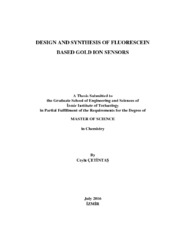Please use this identifier to cite or link to this item:
https://hdl.handle.net/11147/4835| Title: | Desing and Synthesis of Fluorescein Based Gold Ion Sensors | Other Titles: | Fluoresin Bazlı Altın İyon Sensörlerinin Tasarımı ve Sentezi | Authors: | Çetintaş, Ceyla | Advisors: | Emrullahoğlu, Mustafa | Keywords: | Gold ions Gold Fluorescent probes Chemical reactions Fluorescein |
Publisher: | Izmir Institute of Technology | Source: | Çetintaş, C. (2016). Desing and synthesis of fluorescein based gold ion sensors. Unpublished master's thesis, İzmir Institute of Technology, İzmir, Turkey | Abstract: | Gold has been a part of people’s lives for ages and is used as money, goods and jewellery. In recent years, gold has played a key role in chemistry, medicine and biology. Since the 1970s, gold has been extensively used as a catalyst in several chemical transformations. Due to its high biocompatibility, functionalized gold nanoparticles have been extensively employed as drug and gene delivery systems, biosensors and bio-imaging materials. However, gold complexes can become toxic to the human body by interacting with biomolecules such as DNA and enzymes. Therefore, detection of trace amounts of gold species is an important issue and can be achieved via spectroscopic methods such as atomic absorption spectroscopy, atomic emission spectroscopy and inductively coupled plasma spectrometry. However, these analytical methods require complicated sample preparation steps and sophisticated instrumentation. In contrast to these extremely expensive and time-consuming methods, fluorogenic or chromogenic methods, which provide high analyte sensitivity and selectivity, can serve as good alternatives for detecting gold species. To develop new probes for the detection of Au3+ ions, we focused on the design of new fluorescein-based probes that are soluble in aqueous media. We aimed to investigate the in vivo activity of these fluorescent probes. In the proposed detection system, gold ions are expected to mediate a chemical reaction through coordination to an alkyne moiety that results in a ring opening reaction to yield a highly fluorescent derivative. Altın, ilk uygarlıkların sarı parlayan külçeler halinde keşfettiği ilk metaldir. Altın yüzyıllar boyunca insanların hayatında para, eşya ve takı gibi birçok farklı alanda kullanılmıştır. Son yıllarda altın türevleri kimya, tıp ve biyoloji alanlarında önemli bir rol oynamıştır. 1970’li yıllardan günümüze altın türevleri birçok kimyasal reaksiyonda katalizör olarak kullanılmıştır. Romatoid artrit, astım, tüberküloz, sıtma, kanser, HIV ve beyin lezyonları gibi çeşitli hastalıkların tedavisinde altın bazlı ilaçlar kullanılmaktadır. Altın nanoparçacıkları, biyolojik sistemlere uyumlu olması sebebiyle, ilaç ve gen taşıma amaçlı ve biyo-görüntüleme malzemeleri olarak kullanılmaktadırlar. Fakat altın kompleksleri DNA ve enzimler gibi biyo-moleküllerle kuvvetli etkileşimler yaparak insan vücudu için toksik olabilir. Bu sebeplerden dolayı, altın türlerinin eser miktarlarının tayini oldukça önemlidir. Atomik absorpsiyon ve atomik emisyon spektroskopisi, indüktif eşleşmiş plazma spektrometresi gibi spektroskopik yöntemler kullanılarak eser miktarda altın tayini yapılabilmektedir. Fakat bu yöntemler için karmaşık örnek hazırlama aşamaları ve sofistike cihazlar gerekmektedir. Oldukça pahalı ve zaman alıcı yöntemlerin yanı sıra, yüksek analit duyarlılığı ve seçiciliği olan, daha kolay örnek hazırlama ve daha basit cihazlar gerektiren florojenik ve kromojenik yöntemler ile eser miktarda altın tayini yapmak iyi bir alternatif olabilir. Altın iyonlarının tayini için “Fluorescein” yapısında suda çözünür yeni kemosensörler tasarlamayı ve bu sensörlerin hücre ortamındaki aktifliğini belirlemeyi amaçlanmıştır. Bu çalışmada altın iyonunun alkinofilik özelliğinden ve floresein yapısının kendisine özgü olarak gerçekleştirdiği halka açılma reaksiyonundan faydalanılarak etkin bir sistem geliştirmek amaçlanmıştır. Böyle bir sistemde, ortamda bulunan altın iyonları kemosensörün üzerindeki alkin yapısıyla etkileşerek yeni bir yapı oluşturur ve halka açılma tepkimesi sonucunda bu bileşik floresan ışıma yapar. |
Description: | Thesis (Master)--İzmir Institute of Technology, Chemistry, İzmir, 2016 Full text release delayed at author's request until 2017.08.15 Includes bibliographical references (leaves: 47-51) Text in English; Abstract: Turkish and English x, 44 leaves |
URI: | http://hdl.handle.net/11147/4835 |
| Appears in Collections: | Master Degree / Yüksek Lisans Tezleri |
Files in This Item:
| File | Description | Size | Format | |
|---|---|---|---|---|
| T001485.pdf | MasterThesis | 2 MB | Adobe PDF |  View/Open |
CORE Recommender
Page view(s)
198
checked on May 12, 2025
Download(s)
130
checked on May 12, 2025
Google ScholarTM
Check
Items in GCRIS Repository are protected by copyright, with all rights reserved, unless otherwise indicated.